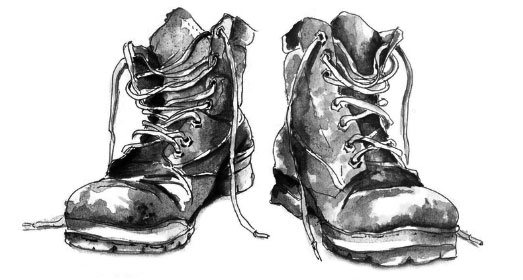BY ELIZABETH MCGOWAN
A Salve for the Heart and Soul
February 18, 2022
I HADN’T SET OUT TO WRITE A LOVE STORY. NOR HAD I EVER PLANNED to pen a piece about my Appalachian Trail thru-hike, figuring the universe was flush enough with such blow-by-blow accounts.
What I had set out to do was make sense of all I had absorbed during a solo, continental bicycle ride I undertook, ostensibly to mark being five years cancer-free. The story that spilled out in what became Outpedaling ‘The Big C’: My Healing Cycle Across America surprised me.
Yes, I could comfortably fill chapters with riffs and perspective on the characters and geography I so cherished along my ride. But, I owed readers more than a linear recitation.
I needed to lay bare my arduous melanoma journey and, more pressingly, rediscover my joyous yet explosive father. He died of melanoma at age forty-four, when I was fifteen. How could I truly know myself — and grow — if I didn’t understand his essence? Extracting such painful truths meant directing tough queries inward — the opposite of what a reporter usually does — and being vulnerable enough to answer honestly.
Upon publication, I remember breaking into a sweat when a television interviewer was effusive with his praise. The theme of my book, he insisted, was love and deep appreciation for my father, my spouse-to-be I met on the A.T., restoration endeavors on protected land, long-distance adventure, curiosity and the healing that allowed for such introspection.
At first, I thought, huh? Then, aha, I nodded in agreement.
Love doesn’t come in an instant and remain. It needs a willing, diligent, flexible, and educable steward. Figuring out how to tend to a scarred but venerated landscape can be as complicated as nurturing a human relationship. Time and research beyond the superficial must be invested for any bond to flourish beyond fleeting.
After all, it’s with that learning that love, and a commitment to the values we find worthwhile, can take root.
Reading a December tribute to cultural critic bell hooks reminded me that love is first and foremost about knowledge. Love not only “requires integrity,” the recently deceased author said, but also a “congruency between what we think, say, and do.”
Spot on, don’t you think?
~ ELIZABETH MCGOWAN
EXCERPT FROM CHAPTER 25
OUTPEDALING THE BIG C
BOOTS ON THE GROUND
ONCE I BECAME FIXATED ON A GEORGIA-TO-MAINE WALK, I WAS LIKE THE proverbial dog with a bone. I wouldn’t let go. Yes, I was incredibly disappointed my fourth round of chemotherapy in autumn of 1989 hadn’t extirpated my lung tumors, but was I just supposed to hope I didn’t die at my newsroom desk? I figured an extended break from the daily demands of journalism and the needles, scans, and probes would be purifying. Weekend walks in the wilderness wouldn’t suffice. I needed full immersion.
In 1990 and early 1991, between covering government meetings, writing feature articles, and plugging away on an exclusive investigative series about a child abuse scandal in the county social services department for the newspaper in Wisconsin, I began plotting my thru-hike. That was Appalachian Trail-speak for a continuous end-to-end trek. I dug into Trail literature and began stockpiling a tent, sleeping bag and pad, stove, water filter, boots, backpack, and other supplies. I decided that my thru-hike should be a clean break. Sabbaticals weren’t common at small daily newspapers, and I couldn’t fathom returning to the same place and schedule. The few people who knew what I was up to told me I was courageous to embark on such a hike without knowing what would come afterward. Deep down, I didn’t see myself as brave. If anything, I was afraid I was being cowardly by running away to an adventure in the woods instead of sticking with my chosen profession. But, staying put seemed too safe. To save my life and sanity, I needed to move on.
In the fall of 1990, a fellow newspaper reporter had made tenuous plans to hike with me. She even drove to Virginia with me in late winter 1991 to attend a hands-on seminar taught by a quirky veteran Appalachian Trail backpacker. Despite that effort, part of me sensed her enthusiasm for a long-distance adventure was waning. So, I wasn’t too shocked when she backed out two months before we were scheduled to start. Instead of letting that setback put the kibosh on my trip, I reshaped it into a solo venture. I traded in my two-person tent for a smaller and much lighter model.
On the practical side, I had to arrange for health insurance coverage during my hiatus and figure out how to distribute my few belongings. Although I hadn’t commanded exorbitant wages as a reporter, I’d squirreled away what I calculated was enough money to support a shoestring hike. I left my job by mid-March and began doling out my stuff to willing friends. Wilbur, my delightful Maine coon cat, and I flew to Massachusetts because my mother had agreed to be his caretaker. Back in Wisconsin, I finished cleaning out my apartment and preparing my gear.
Fortuitously, a Wisconsin colleague who had recently moved to the South Carolina coast agreed to drive me from her new home near Charleston to the Trail’s southern terminus in Georgia. I just had to transport myself to her home in early April. I was pretty much a backpacking rookie when my South Carolina friend and I piled into her Jeep and headed to Springer Mountain in the heart of the Chattahoochee-Oconee National Forest. Yes, I had day-hiked and had tent-camped for years, but that was a far cry from carrying my entire house on my back.
On the afternoon of April 13, 1991 — two days before my thirtieth birthday — I was standing at an elevation of 3,782 feet in the fog of Springer Mountain, poised to take the first of an estimated five million steps toward Katahdin in Maine’s Baxter State Park. The fourteen-state footpath, completed in 1937 along the spine of the eastern mountain ranges, was conceived by Benton MacKaye, a Massachusetts conservationist and regional planner. In 1921, he published an article in an architectural journal outlining what some called a harebrained and unachievable scheme. Some friends and co-workers, I am positive, thought my hike was equally ludicrous. But, I didn’t care. I just wanted to get started.
As I walked north in Georgia, following the white, two-by-six-inch rectangular blazes painted on trees, I discovered that backpacking agreed with me. I naturally bent toward minimalism and had always attempted to honor the adage about beauty in simplicity. Less really is more. And that didn’t mean leading an ignorant, unfulfilled life as an angry or isolated Luddite. It was about being aware that a world prepackaged with an overabundance of bells and whistles often offers nothing more than a deafening cacophony. Choices are wonderful, but just how many flavors of mustard do we really need on the grocery store shelves? Comedian George Carlin was on the mark with his wise skewerings of conspicuous consumption. Our homes, he joked, were nothing more than multi-room storage bins for unbelievable amounts of “stuff.”
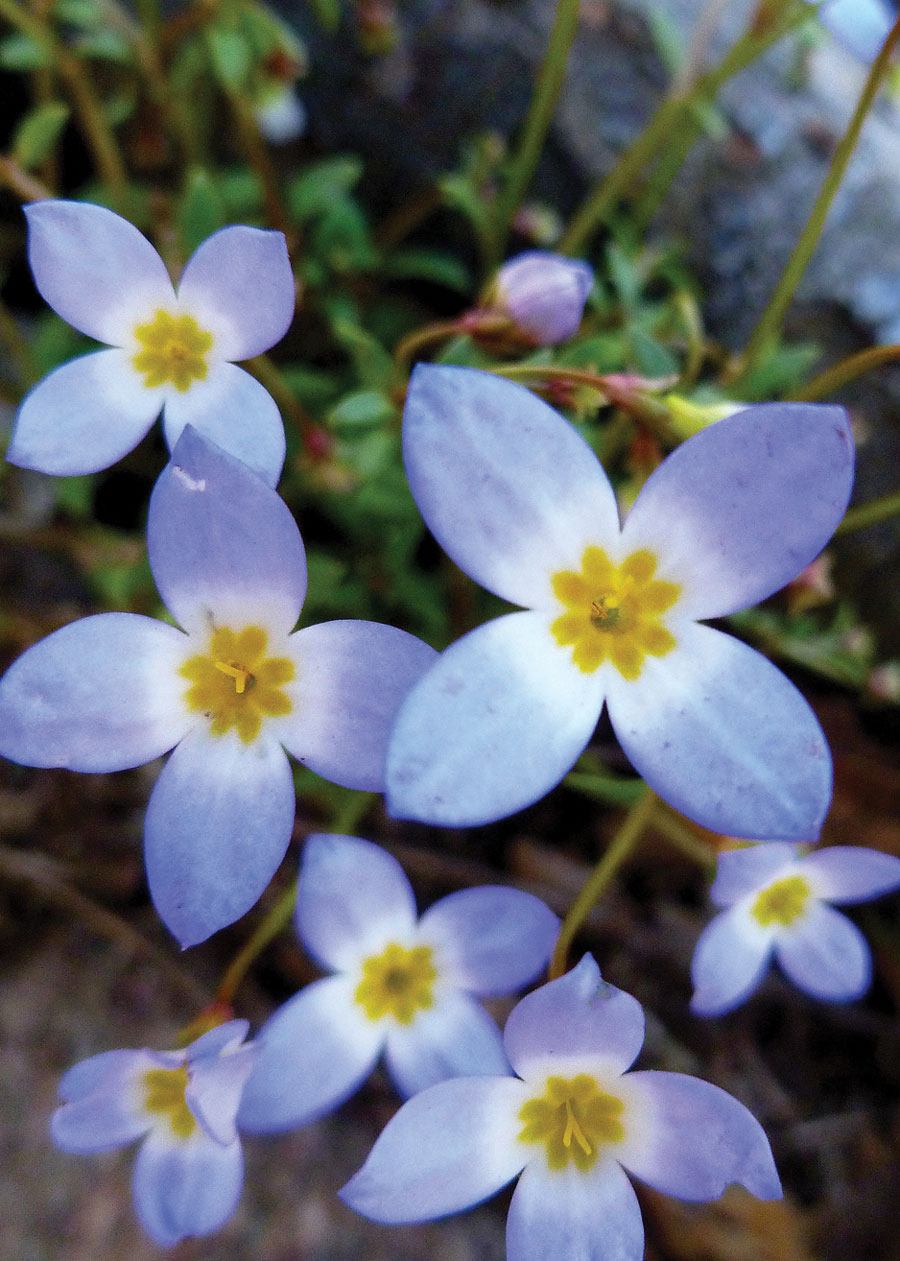
Bluets on the Trail – Photo by Mike Adamovic
I felt so happy hiking. The walking was demanding but not draining. I had such an uncomplicated sense of purpose. Everything I needed was scrunched into my red-and-black external frame backpack. And with each meal, my load lightened. At night, I slept on Mother Earth’s belly under stars undimmed by light pollution. By day, I befriended an assortment of characters — “Mountain Goat,” “Weather Carrot,” “Hippiechick,” “Sleepwalker,” “Six-Foot Hobbit,” “Trail Chef,” “Yin and Yang,” “Problem Child,” “Lollygagger,” “Web Breaker,” “Pregnant Rhino in Heat,” “Judge Roy Bean,” and “Bad Dog”—all pursuing their own adventures. On sunny days in Georgia, when delicate flowers known as bluets optimistically poked through rock crevices in the middle of the Trail, I would lift my face skyward and ask if this splendor ever had to end. When feeling observed while writing in a journal at one of the three-sided wooden shelters along the way, I usually spotted a curious white-tailed deer watching from the underbrush.
My body toughened up as it reset its center of gravity and adjusted to carrying up to forty-five pounds of gear and food. I huffed up grueling ascents in Georgia and tried to keep my toes from turning to mush as they slammed forward in my boots on steep descents. Acquiring a “Trail name” is a tradition and most hikers learn it’s better to christen yourself so as not to be cursed with one you despise. Three days in, I became “The Blister Sister.” Some hikers insisted I must be a nun, but I cleared up those misconceptions by pointing to a plastic bag laden with a less-than-sanitary collection of moleskin, tape, bandages, and other first-aid supplies for my afflicted feet. All I lacked was an attending podiatrist.
Besides the hefty pack, I had a heavy load on my mind too. Before I left for Georgia, my Wisconsin doctors had strongly recommended that I detour from the Trail for a checkup with an oncologist. The tumors in my lungs weren’t all that worried them. They were also monitoring something small but potentially suspect on my liver. They gave me the number for a clinic in Charlottesville, very close to the Trail in the Blue Ridge Mountains of Virginia. I said I would think about it.
ON SUNNY DAYS IN GEORGIA, WHEN DELICATE FLOWERS KNOWN AS BLUETS OPTIMISTICALLY POKED THROUGH ROCK CREVICES IN THE MIDDLE OF THE TRAIL, I WOULD LIFT MY FACE SKYWARD AND ASK IF THIS SPLENDOR EVER HAD TO END.
I muscled my way out of Georgia and along the North Carolina- Tennessee border, sorry I had arrived too early to see magnificent rhododendron thickets in bloom. By mid-May, I was about a month into my hike and feeling fine as I neared the Virginia border. About a quarter of the Appalachian Trail, some 525 miles, traverses the state. I promised myself I would make that doctor’s appointment when I neared Charlottesville.
Trail hikers tend to bunch together, creating cliques and moving along with the same clump of people. I was content to walk alone, pondering and wondering. I didn’t mind the company of others when I stopped for the night, but I was equally satisfied to pitch my tent in a more isolated area. I wanted to hike my own hike, not somebody else’s.
Several miles into Virginia, I met another northbound hiker who looked slightly familiar. He introduced himself as Don. I recognized his Trail name, “Tiger Tunez” — a play on being a graduate of Clemson University and his last name of Looney — because that was how he signed the spiral-bound journals left in the shelters by hiking club volunteers who maintain the Trail. He had introduced himself back in North Carolina where the Trail crosses the Nantahala River. I was heading north out of Wesser, a little town that caters to kayakers and rafters, and he was just walking into town when we first said hello. That’s when I found out he had also started his hike at Springer Mountain on April 13, a few hours ahead of me. I hadn’t thought too much of that encounter because thru-hikers usually engage in such chit-chat.
When I met Don for the second time near a shelter in Virginia, he offered me crackers from his backpack. That was unusual. Hikers are usually so ravenous that, understandably, they tend to guard their victuals closely. He also told me he had been reading the observations I was recording in the Trail journals. Before texting and cell phones, those dog-eared journals served as a Trail grapevine along what amounted to a linear community. Word traveled north and south. Farther along in Virginia, Don confessed that he had calculated how far away I was by the time and date on my journal entries—and picked up his hiking pace so he could catch up to me in Virginia. He had fallen a bit behind when a hiker friend joined him for several days in North Carolina and Tennessee.
As the responsible adult I prided myself on being, calling the Charlottesville clinic haunted me. I kept putting it off. The truth was, I was finding the Trail rhythm so magical that I wanted to keep it needle-and scan-free. Sometimes, lying in my tiny tent at night, my pack stashed under the fly and my food and toothpaste stowed in a bag hanging from a tree limb to keep it out of reach of bears and other critters, I would play a tortuous mind game. It went like this: If I did see the Virginia oncologist and he discovered more cancer, what would he and other doctors be able to do about it? It’s not as if a melanoma cure had emerged in the last eighteen months. And, if the Virginia oncologist found the tumors in my lungs—or the spot they were monitoring on my liver—hadn’t budged or grown, then the journey to Charlottesville would be a colossal waste of time.
After the cracker-sharing episode, Don and I started hiking together, off and on. We walked at about the same pace. He told me he had planned on hiking only as far as Harpers Ferry, West Virginia, the scenic town at the confluence of the Shenandoah and Potomac Rivers. The geographic halfway point of the Appalachian Trail is in Pennsylvania, at Pine Grove Furnace State Park. But, for hikers intent on reaching Maine, Harpers Ferry has a reputation as the “psychological halfway point.” If northbounders make it that far, they are more likely to climb Katahdin.
In Virginia, Don and I started a pattern of hitchhiking into a town every seventy-five Trail miles or so to stock up on food at small country stores. At the checkout line one day, Don noticed a tabloid headline blaring the news of actor Michael Landon’s liver cancer diagnosis. “Oh, that’s awful,” Don said. “I always really liked him.” My stomach tensed. I just nodded.
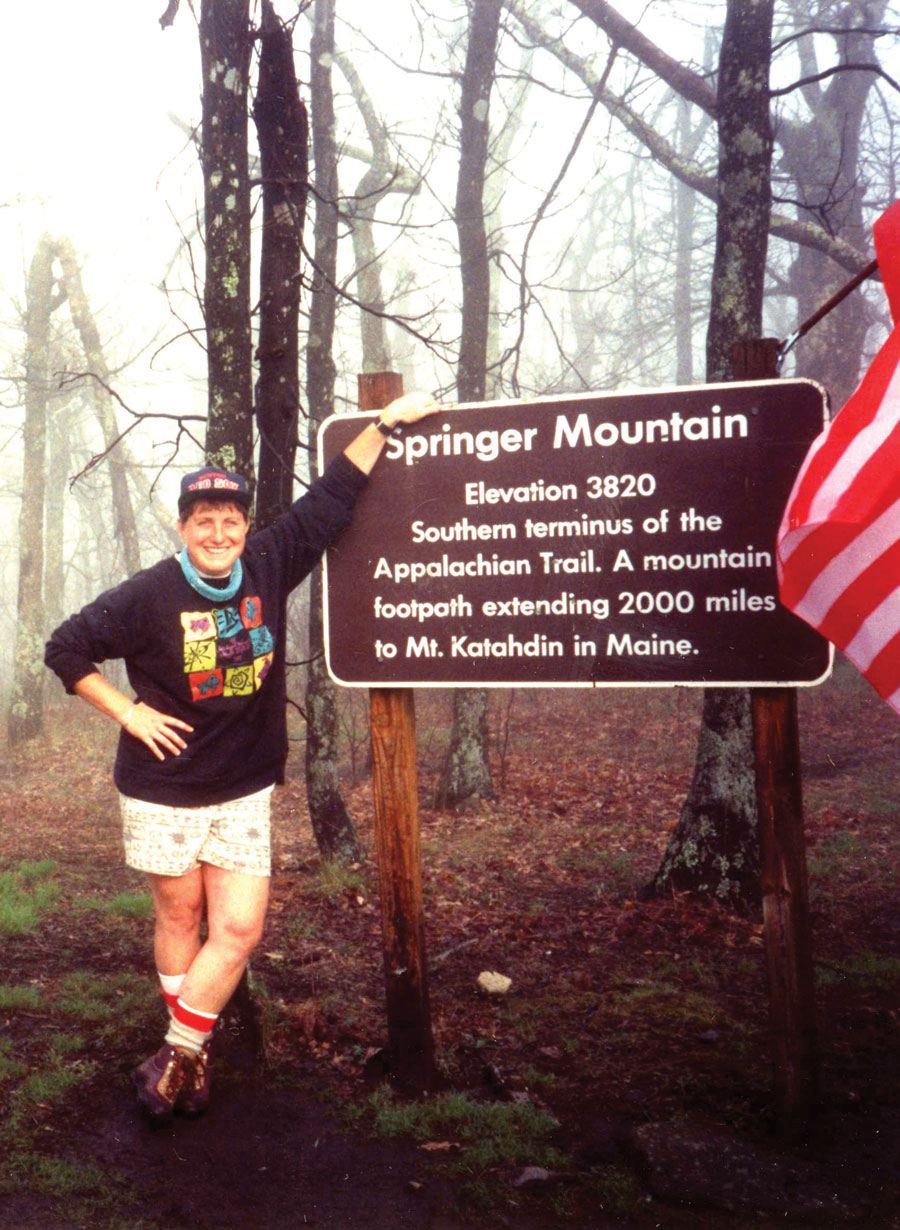
Elizabeth at Springer Mountain on April 13, 1991, before beginning her thru-hike.
When I realized Don and I were forming more than a casual bond — though we continued to pitch our separate tents —I was quite blunt about my own cancer.
“You’ve earned my trust, so I think it’s only fair I tell you the gory details of my cancer surgeries and treatments,” I told him as we stomped up yet another climb. “I’ve had the same sneaky disease that kept re-erupting in my father’s body before it finally killed him. I never asked my father if his cancer ever made him feel like damaged goods. But, I suspect it did because I know mine does, at least sometimes.”
Don had witnessed the cruelties of cancer in his own family. Several years prior, doctors had reconstructed his father’s digestive tract after a cancerous tumor nearly destroyed the older man’s esophagus. Don had moved home temporarily to help his mother with caretaking duties.
Despite my cancer confessions, Don’s steadfastness and apparent devotion didn’t dwindle. This very competent hiker with the bright blue eyes and sometimes hard-to-understand drawl from the South Carolina piedmont kept showing up just about every morning when I was executing what weightlifters refer to as a “clean and jerk” to hoist my pack onto my T-shirt-clad back. We would split a packet of Pop-Tarts or boil water for oatmeal before setting off. Part of the attraction was our shared values. We both appreciated the natural world and the ability to hike together without feeling obligated to fill silences. Plus, we were both devoted baseball fans.
When I asked why he wasn’t scared off yet, Don told me, “Well, I like who you are. And I’ve never met anybody else like you.” His appreciation for individuality resonated with me. I had to admit to myself—and out loud to Don—that I had not yet been fortunate to meet anybody like this quietly persistent and patient person either.
One day after we had hiked beyond Charlottesville, I told Don about the potential trouble brewing in my liver and why I had gone silent when he mentioned the headline about Michael Landon’s cancer. Still, I said I was feeling great and figured I could wait until my hike ended to see a doctor. Maybe that was a cavalier exercise in foolishness and denial, but that’s what I decided. By then, I knew Don had a habit of including a short summary of each day in his succinct Trail journal. It always included a plus and a minus. I asked him about his entries that day. His minus was mentioning the Landon headline to me, and his plus was hiking with me.
Not long after that conversation, we were closing in on West Virginia. Don told me he was lengthening his hike. Instead of taking the train home in Harpers Ferry, he planned to hike to Maine with me. His work in construction as a glazier evidently allowed him three additional months off.
Beyond West Virginia, we agilely two-stepped across the millions of pointy, sharp rocks that coat the Trail in Pennsylvania. During that summer’s drought, we were in search of the next freshwater spring that hadn’t dried to a trickle. I realized physical toughening wasn’t the only change my body was undergoing. Something else—a total surprise—was also happening. Most unexpectedly, I was falling in love, or at least very strong like.
DESPITE MY CANCER CONFESSIONS, DON’S STEADFASTNESS AND APPARENT DEVOTION DIDN’T DWINDLE. PART OF THE ATTRACTION WAS OUR SHARED VALUES. WE BOTH APPRECIATED THE NATURAL WORLD AND THE ABILITY TO HIKE TOGETHER WITHOUT FEELING OBLIGATED TO FILL SILENCES. PLUS, WE WERE BOTH DEVOTED BASEBALL FANS.
Friends can confirm that I can be sentimental, but I will never ever be mistaken for a hopeless romantic. Cinderella and those other princess stories never resonated with me. So, no, I was not—ick!—out there in the woods looking for some sort of fairy-tale love. That thought never crossed my mind. Mostly I sought time and space to knit my body and mind back together, away from demanding editors who always wanted one more story and physicians who always seemed to need one more scan, one more blood sample, or some other dreadful procedure.
I also thought maybe I could learn to be a little more forgiving with myself, the person I tended to judge most severely. I didn’t feel as if I knew what wholeness was, but I was certain I had not achieved it yet. When I looked at myself, I often saw something scarred and broken, and could not imagine why anybody else would want to be around that for longer than they had to be. Humor was the shield I used to deflect the pain that sprang from those insecurities. If I kept other people laughing, maybe they would be distracted enough not to notice my messy shortcomings unfolding before them.
Don and I persevered. In New Jersey, we were rewarded with a black bear sighting and an incomparable sunset. In Connecticut, I had to break in new leather boots because the originals that had carried me from Georgia were as smooth-bottomed as the pair of Keds sneakers I’d worn as a small child. This was, er, no small “feat” for a hiker who hadn’t been able to shed the name “The Blister Sister.” The vendor in Wisconsin who sold me the original boots had promised to replace them if they didn’t last the whole trip. He followed through by mailing that new pair to a post office in New England.
Don met my mother on the Trail twice—once when she joined us with family friends for a meal and laundry session in Massachusetts, and a second time when she drove to Vermont by herself so the three of us could have a picnic on a town green. Farther along in Vermont, Hurricane Bob drenched us and everything in our backpacks for several days. The bog boards positioned over perennially wet sections of Trail were sodden enough to be dangerous. When I slipped on one board and fell hard, I feared I would “turtle,” that is, land on my pack and my back with my feet in the air, unable to right myself. However, I was so physically fit by then that I bounced back up like a rubber ball.
One night above the tree line in the White Mountains of New Hampshire, Don and I wedged ourselves into a space about the size of a dining room table with three other hikers who had pitched a small tent askew. It was the only flat stretch near the Trail. We were so tired after rock-hopping all day that we couldn’t wait for our noodles to finish cooking. We ate them almost raw. There was no space for another tent, so we pulled on all of our clothes, wormed into our sleeping bags, then spent the freezing night trying to avoid and forget the rocky edges poking us everywhere.
By the time I reached Maine, I instinctually knew how to tackle the hand-over-hand climbs and squeezes required to crawl through spills of house-size boulders. More daunting were the rains, which transformed usually fordable, bridgeless streams with rocky bottoms into raging rivers. At one crossing, the current was formidable enough to sweep away even the most surefooted hiker. Stepping in it would be folly. Instead of waiting a few days for the water level to drop, Don and I stripped off our packs and inched across the maelstrom on crisscrossed fallen logs that we hoped would be strong enough to hold our weight. The key was keeping our eyes on the opposite bank, not the roiling wetness below.
We averaged about one rest day per week. On the others, we walked twelve to twenty miles a day powered by Pop Tarts, oatmeal, peanut butter, rice, and noodles, occasionally supplemented with embarrassing episodes of gluttony at restaurants in Trailside towns where proprietors were still foolish enough to offer all-you-can-eat buffets.
WHEN I ASKED WHY HE WASN’T SCARED OFF YET, DON TOLD ME, “WELL, I LIKE WHO YOU ARE. AND I’VE NEVER MET ANYBODY ELSE LIKE YOU.” HIS APPRECIATION FOR INDIVIDUALITY RESONATED WITH ME. I HAD TO ADMIT TO MYSELF—AND OUT LOUD TO DON—THAT I HAD NOT YET BEEN FORTUNATE TO MEET ANYBODY LIKE THIS QUIETLY PERSISTENT AND PATIENT PERSON EITHER.
By the time we reached Baxter State Park in inner Maine in early October, we were lean, mean, calorie-burning hiking machines. Baxter is home to 5,270-foot Katahdin, the northern terminus of the Trail, and northbounders can be barred from climbing the mountain if the weather makes it too dangerous or if rangers have shut it down for the season. After a few days of waiting for dark clouds to clear, October 8 dawned as a cold but “Class A” day. As I hoisted myself up boulders via metal bars bored into granite and picked my way over rime-ice-covered stones, I laughed at the way Trail maintainers in Maine seemed to delight in choosing the most convoluted route. I cried at the thought of the journey being over but simultaneously relished the idea of trading my stinky sleeping bag for a mattress with sheets.
After Don and I summited Katahdin together, we joined several other thru-hikers for a few days of recovery at a cabin in Maine owned by one hiker’s family. Within a week, my mother came to pick us up. The three of us spent several days exploring the state’s rocky coast before heading back to my mother’s house in western Massachusetts. A few days later, Don took the train back to South Carolina, and I made plans to return to Wisconsin. We had no idea when we would see each other again.
I had to launch a job hunt, but my overarching worry was my health. After skipping the appointment with the Charlottesville oncologist, I knew I had to act. Reluctantly, I made an appointment at the New Hampshire oncology clinic and drove there alone from my mother’s house. Whatever happened, I would have to figure out how to live with the consequences.
A young, vigilant doctor examined every inch of my exterior and performed numerous routine tests. He then ordered a series of lung X-rays and promised to call me with the results.
“Elizabeth, this will probably shock you as much as it does us, but we can’t find any spots on your lungs,” the doctor said on the phone a few days later. “They’re clean.”
My Wisconsin doctors were just as shocked when I relayed the astounding news. They didn’t ask about my liver, and I didn’t bring it up, content to leave well enough alone.
No doctor had a medical explanation. It could have been a delayed reaction to the chemotherapy regimen. There had been no studies, of course, about the possibility of tumors disappearing after six months spent walking, drinking spring water, inhaling mountain air, and burning every calorie that noodles, rice, oatmeal, Pop Tarts, and chocolate can provide.
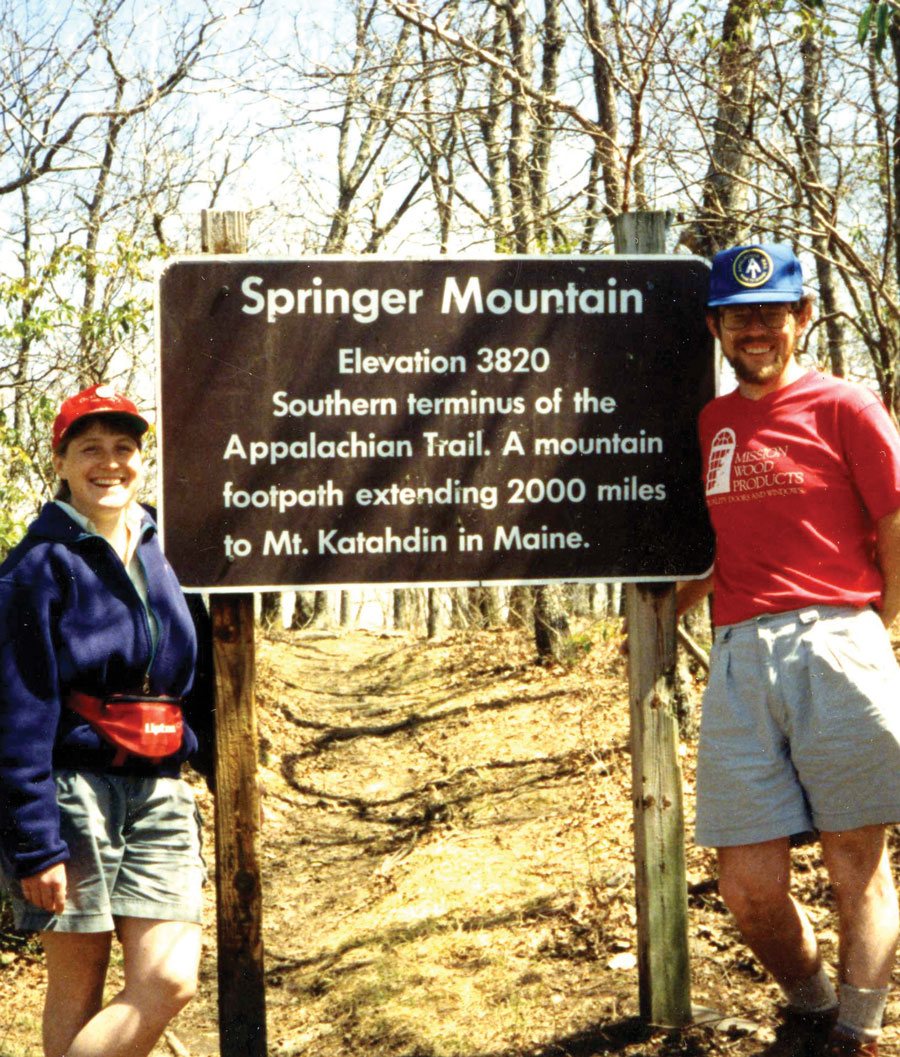
Elizabeth and Don revisit Springer Mountain in 1992, the year after finishing their thru-hikes.
I had always thought it a bunch of malarkey that Norman Cousins healed himself by laughing. Where was the science in that? Now, I wasn’t so sure. My questions didn’t mean I was on the verge of shunning Western medicine. That would be ridiculous. Maybe I was just living proof that a body could regain equilibrium with a combination of chemotherapy and an adventure that seemed a salve for the heart and soul.
When I told my mother the astonishing news, she exhaled a “Yippee!” In the next breath, she told me how, as a stubborn baby, I had graduated from crawling to knee-walking, developing thick calluses as I barreled across bare floors, braided rugs, and even cement. The pediatrician had told my parents not to worry. I would walk when I was ready. One day, several months before my second birthday, my mother was playing a stack of vinyl albums. She entered the living room and found me on my feet, dancing to the soundtrack of “My Fair Lady.” She burst into tears.
Journalist, author, and New England native Elizabeth H. McGowan’s 1991 northbound thru-hike as “The Blister Sister” inspired her to focus her reporting efforts on energy- and environment-related topics. She has won numerous writing awards, including a Pulitzer Prize for “The Dilbit Disaster: Inside the Biggest Oil Spill You Never Heard Of” as a staff correspondent for Inside Climate News.Since 2001, she has lived in Washington, D.C. with Don “Tiger Tunez” Looney, the hiking partner (and later spouse) she met near a white blaze in North Carolina in 1991. Don and Elizabeth served as caretakers at the Blackburn Trail Center near Harpers Ferry, West Virginia, during the 1992 hiking season. To keep their carbon footprint to a minimum, the longtime members of the Potomac Appalachian Trail Club maintain trails in nearby Rock Creek Park. They also remove invasive plant species in Rock Creek as National Park Service-certified Weed Warriors.This chapter is excerpted with permission from the publisher, Bancroft Press. Copyright Elizabeth McGowan, 2020.
This article was originally published in our Winter 2022 issue of A.T. Journeys, the official membership magazine of the Appalachian Trail Conservancy.
Discover More
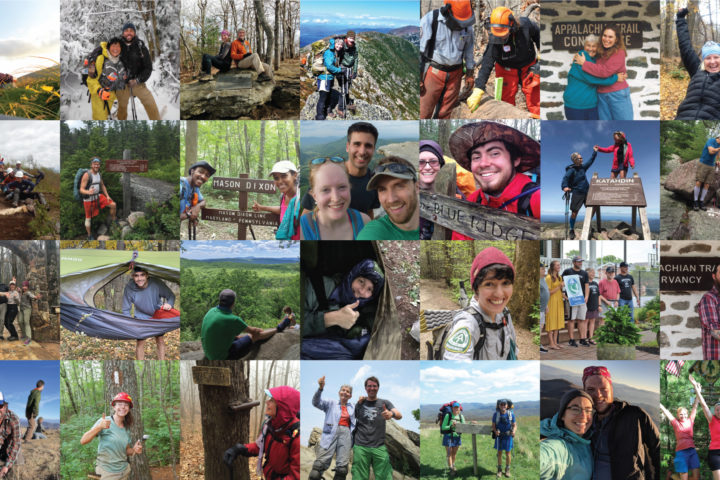
Stories from the Trail
Love Letters to the A.T.
Read stories from the A.T. community about what made people fall in love with the Trail and what keeps that love going strong today.
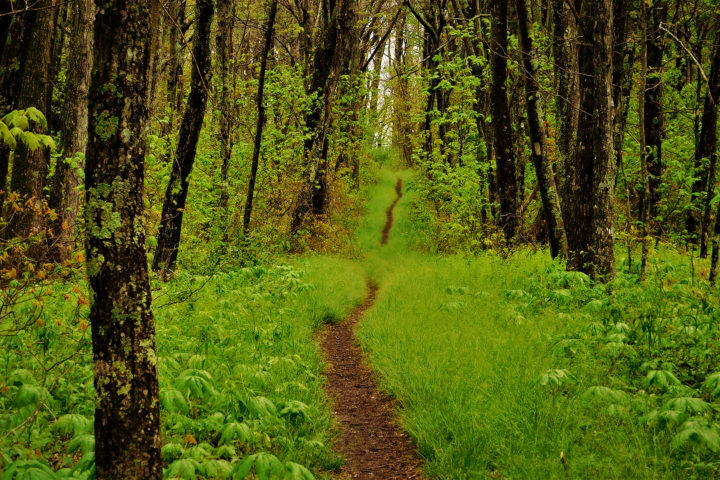
Photo Contest
Natural Beauty: 14 States, Unlimited Inspiration
Selected photos from the “Natural Beauty: 14 States, Unlimited Inspiration” photo contest, which capture the beauty and wonder of the Appalachian Trail and its surrounding lands.
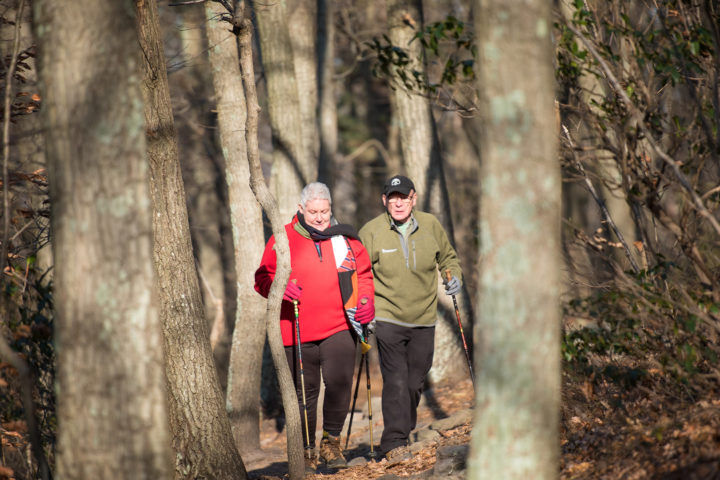
BY SANDI MARRA, PRESIDENT & CEO OF THE ATC
A Love Letter to the Trail
ATC President & CEO Sandra Marra discusses how the relationship with her husband, Chris, was nurtured on and by the Appalachian Trail.

